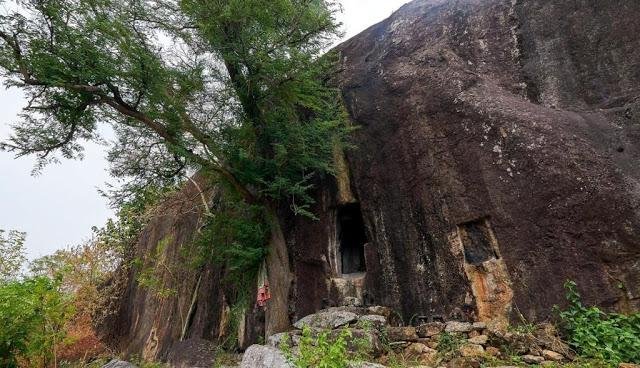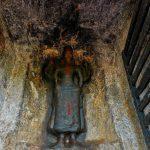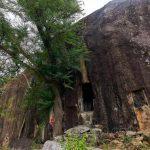Contents
Kurathiyarai Cave Temple, Thovalai, Kanyakumari
| Date built: | – |
|---|---|
| Deity: | Kurathiyarai, Mahavishnu |
| Architectural style: | Dravidian architecture |
| Major festivals | – |
| Locale: | Thovalai |
| District:: | Kanyakumari |
| Address: | – |
| Phone | – |
Architecture
Legend / Local stories
The worship of Avvaiyar in Thovalai taluk in Kanyakumari district is locally as Avvai Nonbu or Avvai Vratham. The Tuesdays of Tamil month Adi is most auspicious for Avvaiyar worship. Womenfolk offer Kozhukkattai (steam boiled rice ball with sweet stuffing) to Avvaiyaaramman. From inscriptions from Chitharal mountain, there was a Jain cave temple at the top of Chitharal mountain and was known as Thiru Charanathu Malai. The monks belonging to the Digambara sect established Thiru Charanathu Palli – the abode of Jain monks during 9th century A.D.
Thiru Charanathu Palli was a dynamic center of Jain learning – a monastery and a school. The male teacher was called Kuravar and the female teacher Kurathi. The word Kurathi also denotes a Jain nun. Influence of Jainism in Kurathiyarai is evident from the first syllable Kurathi. The inscription also cites the Ay king Vikramaditya Varaguna (885-925 AD). The scholars assign the date of the cave to 8th century A.D.
The south facing rock cut cave is excavated on the slope of the hillock at the outskirts of the village. The cave cell is excavated 0.95 cm in width and 1.77 m in height and east-west in orientation. The entrance is 80 cm in width and 1.30 m in height. Local people made provision for wooden door and walls coated with cement. The horse shoe shaped cave excavation remains incomplete and the floor, roof and walls of the cave appear coarse. The sanctum is 1.52 m in east-west in length and 1.13 m north- south in width and 2.04 m in height. The niche carved on the rear wall measures 40 cm in height. The niche, flanked by two square pilasters, houses Lord Vishnu.
The pilasters support the angular potika and uttira. The prastara including vajanam, valabi and kapota are absent. Lord Vishnu image appears in samapatha sthanaka posture on the rear wall and image is dull and smudged with oil. The Lord wears krita makuta, kundala ear-ring, Yagnopavita (sacred cord) runs across his chest, and drapes dhoti as a fivefold tuck in wrap (Pankacha) and the waist cloth (Idaikattu) is tucked with knot. He holds the chanku (conch) in his back-right hand and his back-left hand holds Chakra (disc wheel). His right forearm rests on the hip and the left forehand kept half folded. Scholars assign the date of Vishnu as eighth century A.D.
Two niches are carved outside on the rock slope one on each side of the cave entrance. The niche on the west of the entrance is 89 cm in height and 63 cm in width and houses Vinayagar idol. The Vinayagar is seated in posture described as ‘Lalitasana’ (posture of royal ease) with his right leg drawn up and folded and the left leg resting on the ground. The Lord in Lalitasana represents a calm and relaxed deity and the idol appear with trunk to the right side is known as valampuri Vinayagar. The Lord wears karanda-makutam, sarapali in the neck, armlets, bracelets and short robe around the waist. The right tusk is present while left tusk is absent.
The back-left hand is damaged and the back-right hand shows kapitha mudra. The right fore-hand holds an object which is not unidentifiable and left forehand rests on the lap. The image on eastern niche is left incomplete and sculpting do not show any shape. However, the local people worship this image as Avvaiyar. Although the presiding deity in this cave is Vishnu, the temple is locally known as Avvaiyaaramman Temple. The image on the left side of Lord Vishnu is believed to be that of Avvai.
Photo Gallery
How to Reach:
The Temple is located at about 500 meters from Kurathiyarai Bus Stop, 2 Kms from Derisanamcope, 2.5 Kms from Azhagiapandipuram, 5 Kms from Boothapandi, 16 Kms from Aralvaimozhi, 17 Kms from Nagercoil, 18 Kms from Thovalai, 22 Kms from Suchindram, 35 Kms from Kanyakumari and 76 Kms from Thiruvananthapuram. Kurathiyarai Village is situated in the Nagercoil – Kadukkarai Road. Take diversion before Azhagiapandipuram and find out muddy road and travel one km to reach this village. Nearest Railway Stations are located at Thovalai, Nagercoil and Aralvaimozhi. Nearest Airport is located at Thiruvananthapuram.
Contact Details
Official Address



